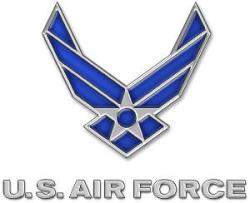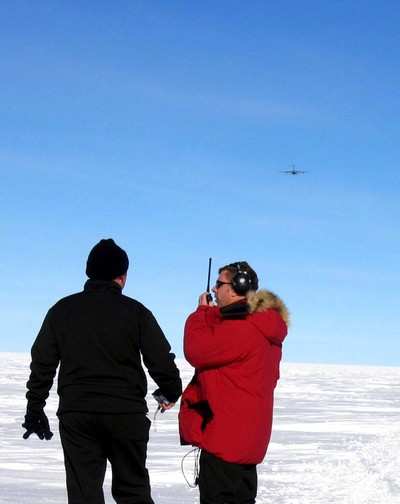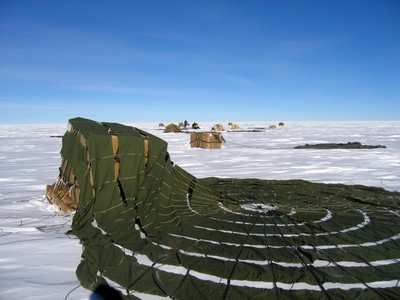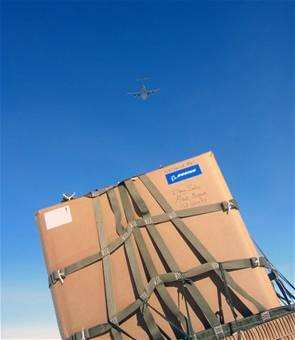 During the winter season at the
South Pole, temperatures often dip as low as minus 100 F and can
paralyze an aircraft's hydraulic systems, crystallize the fuel and
solidify lubricants. However, freezing temperatures did not deter
Joint Task Force-Support Forces Antarctica Operation Deep Freeze
crews and support personnel from validating the C-17 Globemaster
III's polar airdrop capability by successfully airdropping 22,372
pounds of supplies to the South Pole Dec. 18.
During the winter season at the
South Pole, temperatures often dip as low as minus 100 F and can
paralyze an aircraft's hydraulic systems, crystallize the fuel and
solidify lubricants. However, freezing temperatures did not deter
Joint Task Force-Support Forces Antarctica Operation Deep Freeze
crews and support personnel from validating the C-17 Globemaster
III's polar airdrop capability by successfully airdropping 22,372
pounds of supplies to the South Pole Dec. 18.
Twenty containerized delivery system bundles were delivered in
two passes of 10 bundles each. The mission was a combined effort of
JTF-SFA, 62nd Airlift Wing, 446th Airlift Wing, National Science
Foundation and Raytheon Polar Services Corporation personnel.
Airdrop operations were executed at approximately 10,700 feet above
sea level and crew members were on oxygen for the unpressurized
airdrop sequence. Elevation at the South Pole is approximately
9,300 feet above sea level.
"This is an extremely challenging mission, both for the aircrew
and the aircraft," said Lt. Col. Jim McGann, the commander of the
304th Expeditionary Airlift Squadron based in Christchurch, New
Zealand.
"But; it's an absolute critical capability and a skill set we
need to exercise on a regular basis to ensure we can execute an
emergency airdrop on the South Pole within hours of an NSF
request."
This is the second consecutive year that crews have demonstrated
this capability. The first C-17 airdrop of supplies to the South
Pole was successfully completed on Dec. 19, 2006. Approximately
70,000 pounds of supplies were delivered during that milestone
mission.

"This mission is testimony to the flexibility and reach of
airpower," said Lt. Gen. Loyd S. "Chip" Utterback, JTF-SFA
commander. "The airlift, sealift and ground support capability
executed by an integrated total force team operating in an
unforgiving and unique environment make Operation Deep Freeze a
one-of-a-kind mission."
By validating the C-17 capability to complete airdrop missions
at the Geographical South Pole, JTF-SFA demonstrated its ability to
provide mid-winter emergency re-supply and flexible support to the
National Science Foundation and U.S. Antarctica Program. The
ability to airdrop supplies using the C-17 versus the LC-130
Hercules, which is the traditional platform used to airland
supplies on the ice, allows aircrews to deliver up to four times as
much supplies in a single airdrop mission in conditions that do not
allow airland missions.
The extreme temperature, around-the-clock darkness and
crosswinds up to 60 miles per hour create blizzard conditions and
zero visibility, making it impossible for an aircraft to land.

Operation Deep Freeze is a unique 13th Air Force-led joint and
total force mission that has supported the NSF and USAP since 1955.
The 2007-2008 season kicked off Aug. 20. C-17 flights from
Christchurch staged essential personnel and equipment at McMurdo
station to prepare the ice runway for the main C-17 and LC-130
operations which began Oct. 2. Main season resupply consists of
C-17 intercontinental flights between Christchurch and McMurdo and
LC-130 flights from McMurdo to the South Pole and other camps
throughout Antarctica.
As of Dec. 17, C-17s have delivered 2,689,462 pounds of cargo
and passengers to McMurdo, and LC-130s have delivered 3,966,416
pounds of cargo, fuel and passengers to research facilities
throughout Antarctica. Vessel resupply operations begin in January
when Military Sealift Command vessels deliver fuel and supplies to
McMurdo Port.
Operation Deep Freeze is unlike any other U.S. military
operation and is one of the most demanding peacetime missions due
to the extreme adversity of the environment and the remoteness of
Antarctica. Antarctica is the coldest, windiest, driest, highest
and most inhospitable continent on the globe.

The U.S. military is uniquely equipped to assist the National
Science Foundation in the accomplishment of its mission to explore
Antarctica, and the 613th Air and Space Operations Center at Hickam
AFB has the capability to provide joint operational and logistics
support to the NSF around the clock. Operation Deep Freeze involves
active-duty and reserve C-17s from McChord Air Force Base, Wash.,
New York Air National Guard ski-equipped LC-130s, U.S. Coast Guard
and/or commercial icebreakers, and the U.S. Navy Cargo Handling
Battalion One provides port services at McMurdo Station. [ANN
salutes Lt. Col. Toni Kemper, 13th Air Force Public Affairs]
 Classic Aero-TV: Extra; the Airplane, the Man, and His Grand DeLand Plan
Classic Aero-TV: Extra; the Airplane, the Man, and His Grand DeLand Plan ANN FAQ: Follow Us On Instagram!
ANN FAQ: Follow Us On Instagram! Aero-News: Quote of the Day (11.27.25)
Aero-News: Quote of the Day (11.27.25) ANN's Daily Aero-Term (11.27.25): Ultralight Vehicle
ANN's Daily Aero-Term (11.27.25): Ultralight Vehicle ANN's Daily Aero-Linx (11.27.25)
ANN's Daily Aero-Linx (11.27.25)






